- Know how Tarabai assumed power post Shivaji/Rajaram. How Aurangzeb tried to subdue to the Marathas and Tarabai’s counter strategy. She contributed to the downfall of the Mughal Empire, its failure in the Deccan and witnessed the transformation of a nascent Maratha state into an all Indian Empire.
When we talk of Maratha
Queens think of Tarabai, Yesubai, Ahilyabai, and Lakshmibai. This piece is
about Tarabai.
As
fierce goddess Bhadrakali, killed hordes of demons,
Ramrani
(Tarabai) will defeat the army of Aurangzeb;
Beware,
O ye Mughals,
The
time for your annihilation has come, - Govind
Paramanand 1
First
some key dates
Shivaji Maharaj
died in 1680. His son, Rajaram and husband of Tarabai died in 1700. Sambhaji was
executed by Aurangzeb in 1689. Shivaji II (Rajaram & Tarabai son) was born
in 1696. The Marathas fought a 27 year old war with Aurangzeb, from 1680-1707
i.e. he died, in which Tarabai played a very important role. The new Mughal emperor released
Chhatrapati Shahu in 1707 (grandson of Shivaji Maharaj). He was captured with
his mother Yesubai and kept in captivity for about 17 years by Aurangzeb.
Yesubai was released in 1719. Tarabai died in 1761, at the age of 86.
Maharani Tarabai
(1675-1761), was one of the most important contributors to the breakup of the
Mughal Empire. She was the daughter of Hambir Rao Mohite, commander-in-chief of
the Maratha Empire.
Hambir Rao became Commander-in-Chief in the most curious way. Though he was brother-in-law of Shivaji Maharaj (brother of his second wife Soyarabai), he had worked his way upwards in the army, with intelligence and bravery. In early 1674, Prataprao Gujar (Maratha C-in-C) sacrificed himself with some of the top commanders while fighting with Bahlol Khan’s forces at Nesari. The Maratha army was suddenly leaderless and the south-western border of the Maratha state was threatened by Bijapuri invasion just months before the coronation of Shivaji Maharaj.
In this situation
Hansaji Mohite, despite being merely a commander of 100 horses, came forward
and assumed command. The Maratha army routed the Bijapuri one and their
offensive faltered, which resulted in stabilizing the situation before the
coronation. When he proved his mettle, only then, Chhatrapati Shivaji promoted
Hansaji to the post of Sarnaubat
(C-in-C) with the title of Hambir Rao, giving a clear message that in Swarajya,
the ideals are supreme and personal relationship is secondary.2
During the brief
succession struggle after the death of Chhatrapati Shivaji, the faction led by
Maharani Soyarabai and Annaji Datto was expecting support from Hambir Rao. As a
C-in-C of the army his support was crucial for their plans. Even though Rajaram
Raje was his nephew, he supported Sambhaji Raje who was coronated as
Chhatrapati, thus crushing the planned coup with as little bloodshed as
possible.3 For Hambir Rao what
mattered was the imminent threat of Mughal invasion.
Chhatrapati
Sambhaji never forgot this and he planned the marriage of Rajaram Raje with the
Tarabai-the daughter of Hambir Rao in 1683-84.
Tarabai had
inherited the talent & energy of her father, which were displayed by her in
the crucial second and third phases of the 27 year war against the Mughals.4
After the
execution of Chhatrapati Sambhaji by Aurangzeb in 1689, Maharani Yesubai and
Maratha Ashtapradhan Mandal decided to continue the fight with Aurangzeb. They
moved Rajaram Maharaj, for his own safety, to Ginjee an impregnable fort in
Tamil Nadu. This fort was won by Chhatrapati Shivaji during in 1677 during his southern
conquest.5
![]()
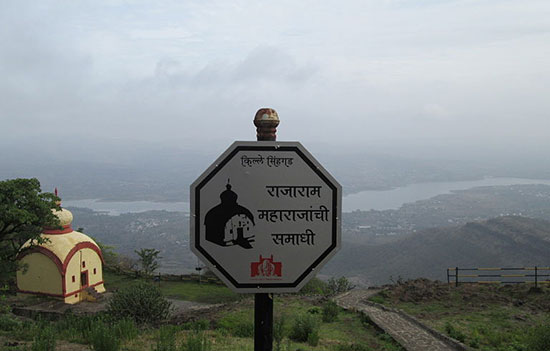 Samadhi Rajaram Maharaj at Singhad Fort. Pic by author.
Samadhi Rajaram Maharaj at Singhad Fort. Pic by author.
The journey of
close to 1300 kms was very hazardous and Mughal forces were in close pursuit,
hence Rajaram Maharaj travelled with select companions to Ginjee and his wives
including Tarabai were kept at Panhala and then at Vishalgad. Since the land
route was infested with Mughal check posts after 1690, they completed the
journey to Ginjee in 1693 via sea from Rajapur to Pondicherry and then covering
the last leg of around 70 kms overland. 6
Here at Ginjee, Shivaji II, the first son of Chhatrapati Rajaram and Tarabai
was born in 1696. 7
The fort of
Gingee, which was the third Maratha capital for 8 years, finally fell to the
Mughal commander Zulfiqar Khan in early 1698.8 Chhatrapati Rajaram returned to Maharashtra and personally
marched towards Varhad, Khandesh. He deputed Maratha nobles like Parsoji
Bhonsale (Varhad), Nemaji Shinde (Khandesh), Khanderao Dabhade (Baglan) to
choke the financial nerve of Mughal army. 9
Chhatrapati
Rajaram died suddenly when he returned to Sinhagad after successfully
completing the operations against Mughal armies (March-1700).10 Aurangzeb, who was then besieging
the fort of Satara, was overjoyed by this news; ‘on receiving this intelligence, the Emperor ordered the drums of rejoicing to be beaten and the soldiers congratulated each other saying that another prime mover in the strife was removed.’ 11
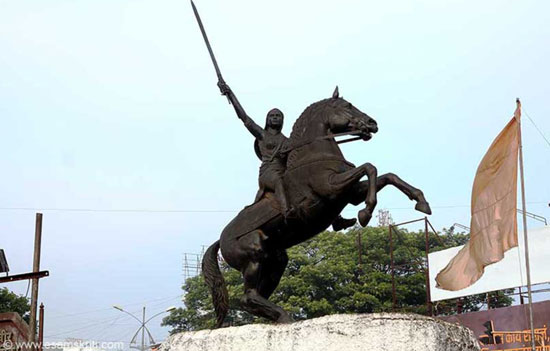 Maharani Tarabai pratima in Kolhapur.
Maharani Tarabai pratima in Kolhapur.
The Mughal-Maratha
war going on for the past twenty years without any respite hence, after the
death of Chhatrapati Rajaram, Maharani Tarabai offered following peace terms;
1) Top rank of
7000 and no compulsory attendance in the court (like Maharana of Udaipur).
2) Deshmukhi (the right to collect the tax-
effectively ruling the territory) from Deccan.
3) If these terms
were ok then seven prime forts like Satara, Panhala, Parali, would be offered to
Aurangzeb and a Maratha army of 5,000 for future operations.12
Whether the peace
terms were genuine or offered to gain a temporary respite can be debated.
But Aurangzeb who had given the call of ‘holy war’ against the Marathas was impervious to continuous wars and sufferings as well as any peace proposals. Khafi Khan had aptly summarized his thinking as ‘it would not be difficult to overcome two young children and a helpless woman. They thought their enemy weak, contemptible and helpless. 13
The peace terms were rejected brusquely by Aurangzeb in just two words ‘Hamakila Badhand’ (translation from Persian- No negotiations till unconditional surrender of every fort). In fact, the death of Chhatrapati Rajaram gave further hope that if given a strong push, the collapse of the Maratha Empire was imminent. Hence he ordered fresh reinforcements from various governors posted in the northern part of India.14
For the details Aurangzeb’s call of ‘holy war’ and campaign against Marathas from 1699 onwards, please refer to the earlier article of the author.
Maratha
Counterstrategy
‘Tara
Bai, as the wife of Rajaram was called, showed great powers of command and
government, and from day to day, the war spread and the power of the Mahrattas
increased. – Khafi Khan
Maharani Tarabai
and her trusted advisers like Ramchandrapant, Dhanaji Jadhav assessed the
situation correctly and devised a strategy to counter the Mughal army. They had
an ideal model where the siege of Ginjee went on for 8 years, tying down a very
large Mughal army with vast resources which otherwise would have been free to
raise havoc in Swarajya. What they were planning is to replicate this model for
the forts in Maharashtra, which Aurangzeb was planning to besiege.
The first step was that the besieged fort
must not surrender quickly; the fort garrison must try to prolong the siege as
long as possible. Maratha field commanders would cut the supply convoys coming
to the besieging Mughal force and continue to harass them with surprise attacks
in the night, along with supply sorties for the besieged fort. By not ceding an
inch without a fight, Marathas forced Aurangzeb and the bulk of his army to
remain immobile at one place for a very long time. Consider the following chart;
Table1-Fort sieges conducted personally by Aurangzeb post-1699
|
Fort
|
Appr Start
|
Appr End
|
App time
|
|
Satara
|
Dec 1699
|
April 1700
|
5.5 months16
|
|
Panhala
|
Jan 1701
|
May 1701
|
6 months17
|
|
Vishalgad
|
Dec 1701
|
June 1702
|
6 months18
|
|
Sinhagad
|
Jan 1703
|
April 1703
|
4.5 months19
|
|
Rajgad
|
Dec 1703
|
Feb 1704
|
2.5 months20
|
The campaign season in Deccan starts after
the monsoon subsides i.e., from October onwards when the lumbering Mughal army
breaks its monsoon quarters and reaches a fort for the siege. The above charts
indicate the same where most sieges start in November-December and go on till
the onset of monsoon i.e., for four to six months.
When the stores were running low and the soldiers couldn’t fight anymore, then the next
step was to start negotiations with the Mughal commanders. Maratha fort commanders used to ask a hefty bribe for the fort’s handover. By then, even Mughal officers besieging the forts were tired; the loss of life and siege materials was heavy, so the planned negotiations were well received. The third step was to take the bribe while
prolonging the negotiations on one or another pretext and then finally handover
the fort.
Even Aurangzeb was aware of this bribery.
Many times, the amount presented by him to the Mughal commander for taking the
fort was equivalent to the amount of bribe paid by him to the Marathas for
handing over the fort. Taking bribe and depositing
it in the treasury of the Swarajya was another tactic to fill the coffers.
This trick was used as the Mughal onslaught for the past two decades had
hampered agricultural and other economic activities which resulted in very low
revenue collection.21
How the Maratha army planned this policy can
be gauged from the reaction of Maharani Tarabai, when she received the news of
the fall of Sinhagad in April 1703. Although the fort commander died during the
siege and garrison struggling with an epidemic, she reprimanded them for
handing them over this crucial fort so soon to Mughals instead of fighting till
the onset of monsoon.22
Now the interesting part
starts. When the Mughal force occupy the fort, they diligently repair the damage they themselves had done to it during the siege. The food and ammunition stores are replenished for the new Mughal garrison. Also, a part of the treasury is shifted to the fort for soldiers' allowance and other expenses. The titles, promotions, money, and fiefs are lavishly distributed for the Mughal commanders besieging the fort. By the time monsoon is over, the focus of Aurangzeb has shifted, and the whole march starts once again to capture the next Maratha fort in the long list.
Once Mughal army marched out of that
particular region, the plan for recapturing the fort was put into effect. In
one dark night, again the fort was attacked in a surgical strike, and by the
next morning, it was back with Marathas with improved fortifications and all
the stores filled from the Mughal treasury. 23
It was beautifully summed up by Owen; ‘Thus, even
had the Mahratta base been effectually mastered, the Dekkan would still have
remained unsubdued and unpacified. But, it was not mastered, though many forts
fell, more with the aid of the golden key (i.e., bribe) than by force of arms. 24
 Tarabai Palace in Panhala Fort.
Tarabai Palace in Panhala Fort.
Maratha armies on Offensive 1705-07
‘Marathas
are gaining ground steadily all over, and so is the frequency of their attacks
all over. Forget defeating; hardly anybody remained capable to even contain
them.’ Bhimsen Saxena. 25
By 1704, the Mughal army captured many
Maratha forts but these victories were symbolic. As the bulk of Mughal army was
either committed towards siege operations or were chasing the more agile
Maratha forces, the gaps left by them were cleverly exploited by the Maratha
army.
In early 1704, Maratha armies crossed
Narmada under Nemaji Shinde and penetrated as far as Sironj, joining hands with
Hriday Shah- the son of Maharaja Chhatrasal.26 In the end of 1704 another army was led by Dhanaji Jadhav, accompanied by Maratha ally Rao Gopal Chandravat which marched towards Surat, Bharoch and Ahmadabad. They defeated Mughal forces and captured nobles like Nazar Ali Khan and Abdul Hamid Khan. The morale of these nobles was so shattered due to this defeat that ‘even after their liberation, many were unable to perform their duties as Faujdars’.27
By taking war to
the areas like Gujarat and Malwa, which the Mughal army had not anticipated, Maharani Tarabai had given a clear message to Aurangzeb
that Marathas are equally determined for the fight to finish. These were
not occasional raids like earlier, now Marathas were trying to get firm
anchorages in these areas by creating a parallel chain of command like Mughal
administration as visualized by Chhatrapati Rajaram before his death.28
When Maratha
armies were on offensive in the areas beyond Narmada, on the home front, many
forts captured by Mughal army were recaptured in the period of 1704-1706.
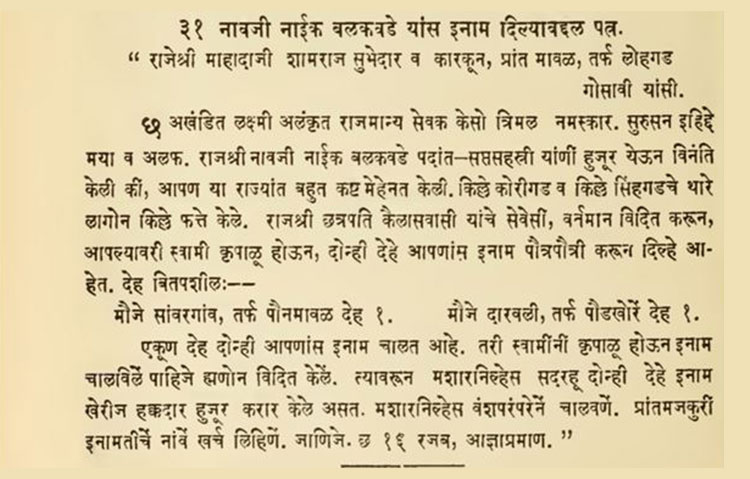
Translation- Renewal of grant for 2 villages (Savargaon
& Daravali) given as Inam (gift) to Navaji Balkavade for the capture of
Sinhagad and Korigad in 1693 from Mughal army. The grant letter was reissued by
Chhatrapati Shivaji II in 1701 after the death of Chhatrapati Rajaram in 1700. 29
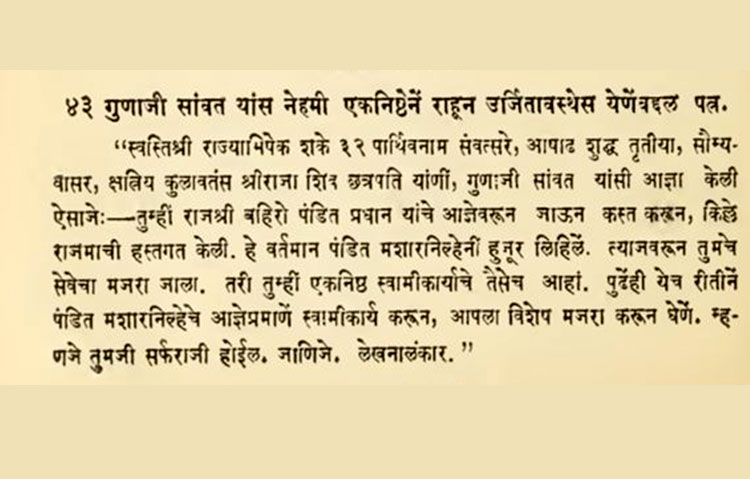
Translation of letter written as an encouragement by Chhatrapati Shivaji II to Gunaji Sawant who captured Fort Rajmachi from Mughal forces in the year 1706. 30
Maratha administration under
Tarabai
Her administrative genius and strength of character saved the nation in the awful crisis that threatened it in consequence of Rajaram’s death. Sir Jadunath
Sarkar
31
Since Chhatrapati Shivaji II was only four
years old (born 1696) when Chhatrapati Rajaram died, we can safely assume that
all the administrative decisions taken in this turbulent period, were either by
Tarabai or after due consultation with her. With the continuation of grants
given earlier by Chhatrapati Rajaram as well as new grants for those who had
shown exemplary courage while fighting the Mughal onslaught, she had shown that
her grip on the Maratha army and administration was firm. There are numerous letters,
grants and other documents which confirm this observation.
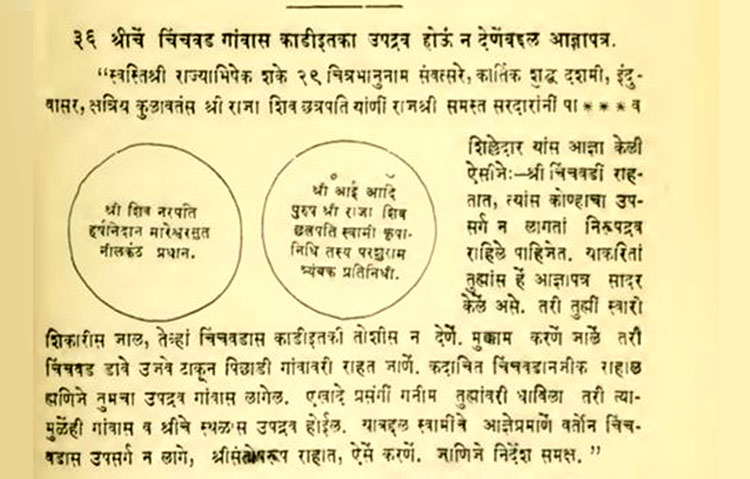
Translation
of Letter-
If Maratha army camps at Chinchwad village, then Mughal army while chasing them,
may attack the village and destroy the Ganesh temple revered by the family of Chhatrapati.
Hence a warning letter sent to Maratha army commanders in October 1703,
instructing them to not to camp at Chinchwad.32
We have seen earlier how Maharani Tarabai
admonished the Maratha forces of Sinhagad when they surrendered the fort before
onset of the monsoon; whereas Santaji Shilimkar and his brother Mahipatrao
received a congratulatory letter for repulsing the Mughal attack on Rajgad. When
Subhanji, the younger brother of Santaji Shilimkar and Santaji died defending
the Purandar and Rajgad forts Tarabai issued annual pension and revenue of
villages to their families as well. This showed her caring nature and grasp on administration.
33
After the capture
of Wakinkhera fort in Karnataka from Pidiya Nayak (another Maratha ally) in
1705, Aurangzeb received intelligence that Marathas had started recapturing the
forts like Sinhagad. Hence he dispatched Hamid-ud-din Khan for recapturing
these forts and the whole cycle of long sieges described earlier began again.
34
Aurangzeb was now
in poor health due to frequent illness, dejected due to renewed Maratha
activity and worried about the fate of Shah Jahan befalling on him due to
intrigues of Azam and Kam Baksh thus he retired to Ahmednagar. But even there he
was not safe as his camp was attacked by Senapati Dhanaji Jadhav. 35
Day after day
Marathas were on the offensive and Mughal forces hammered across vast areas,
stretching from Maharashtra to Tamil Nadu, clearly indicating a reversal of
fortunes.
The victory over Mughals
was finally won by Marathas under Maharani Tarabai with the death of Aurangzeb
in 1707. 36 But Historian Stewart Gordon points out succinctly that, Aurangzeb had ‘lost the Deccan’ as early as 1705. “By about 1705, the Marathas had won the
Deccan by simply not losing. As in many guerrilla wars, the Mughal defeat was not the loss of any particular fort or town, but the loss of the will to keep chasing an enemy that struck and disappeared in the hill or merged with the local populace”. 37
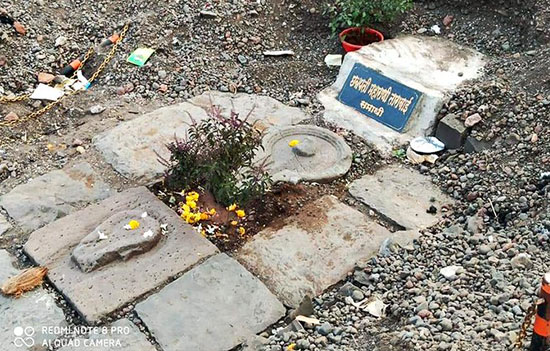 Samadahi Maharani Tarabai. Pic by Manoshi Sinha, author Saffron Swords.
Samadahi Maharani Tarabai. Pic by Manoshi Sinha, author Saffron Swords.
Conclusion
- Maharani Tarabai Life
To sum up her
life, Maharani Tarabai was an extraordinary and inspirational figure. She led
the Maratha Empire, in its existential crisis, from the front. By the time of
her death in 1761; she witnessed the transformation of a nascent Maratha state
in a Pan-India Empire.
After the loss of
the first three Chhatrapatis, the Marathas under Maharani Tarabai fought on
with grim determination and came out triumphant ultimately. In the whole process,
the stranglehold of Mughals on India weakened
considerably, and within merely a dozen years after Aurangzeb’s death, Marathas were in Delhi’s power politics with Sayyid brothers.
This inspiring tale of heroic indigenous resistance and the 27 years war, which should have a prominent place in India’s history curriculum is sadly missing.
To read all
articles by author
Also read about Indian Queens
1. Return
of Queen Yesubai
2. Pilaji Jadhavrao – A Brave Maratha Subedar
3. Rani
Durgawati, Madhya Pradesh
4. Rani
Abakka of Mangalore
5. Hadi
Rani, Rajasthan
6. Kittur
Rani Chennamma, Karnataka
7. Life
story of Rani of Jhansi
8. Life
story of Ahilyabai Holkar
9. Revolt
of the Rani of Attingal
References
1. G.S.Sardesai,
Aitihasik Patrabodh, Pg-24, 1952.
2. K.A. Sabhasad,
Sabhasad Bakhar, Tr-S. Sen Pg-109-10. 1920.
3. G.S.Sardesai, Maratha Period-Volume I, Pg-543, 1915.
4. C.A. Kincaid
& D.B. Parasnis, A History of the Maratha People-Volume II, Pg-110, 1922.
5. G.S.Sardesai, Maratha Period-Volume I, Pg-615, 1915.
6. Ibid, Pg-636.
7. G.S.Sardesai,
Historical Genealogies, Pg-111, 1957.
8. M.
Srinivaschari, History of Gingee and Its Rulers, Pg-347, 1943.
9. G.S.Sardesai, Maratha Period-Volume I, Pg-675, 1915.
10. S.M. Pagadi,
Mogal Darbarachi Batamipatre, O-Pg-262 & 331, 1978.
11. Khafi Khan,
Muntakhabu-l Lubab, Tr- H.M. Eliot, Ed- J. Dawson, Pg-152, 1952.
12. S.M. Pagadi,
Mogal Darbarachi Batamipatre, O-Pg-33 & 332, 1978.
13. Khafi Khan,
Muntakhabu-l Lubab, Tr- H.M. Eliot, Ed- J. Dawson, Pg-152-53, 1952.
14. S.M.Pagadi, Mogal Darbarachi Batamipatre-Volume-1, O Pg-
396, 397, 399, & Volume-2, O
Pg-53, 1983.
15. Khafi Khan,
Muntakhabu-l Lubab, Tr-H.M. Eliot and Ed- J. Dawson, Pg-152-53, 1952.
16. S.M.Pagadi, Mogal Darbarachi Batamipatre-Volume-1, start:
O Pg-276. End: O Pg-351. 1978.
17. J. Sarkar, History of Aurangzib-Volume-V. Start:
Pg-173. 1924. & S.M.Pagadi, Mogal Darbarachi Batamipatre-Volume- 2, End: O Pg-114. 1983.
18. Ibid, start: O
Pg-188. End: O Pg-249.
19. S.M.Pagadi, Mogal Darbarachi Batamipatre-Volume-3, Start:
O Pg-39. End: O Pg-101. 1989.
20. Ibid, Start: O
Pg-171. End: O Pg-327.
21. Khafi Khan, Muntakhabu-l Lubab, Tr- H.M. Eliot, Ed. J. Dowson, Pg-157-58. 1952.
22. S.M.Pagadi, Mogal Darbarachi Batamipatre-Volume-3, Preface
Pg-16. 1989.
23. G.S.Sardesai, Maratha period-Volume I, Pg-710. 1915. &
K. Khan, Muntakhabu-l Lubab, Tr-H.M. Eliot, Ed-J. Dowson, Pg-168,
1952 & S.M. Pagadi, Mogal Darbarachi Batamipatre-Volume-3, O
Pg-481. 1989.
24. S.J.Owen, The Fall of the Mughal Empire, Pg-114,
1912.
25. S.M.Pagadi, Mogal Darbarachi Batamipatre-Volume-3, Preface-
Pg-18. 1989.
26. S.M.Pagadi, Mogal Darbarachi Batamipatre-Volume-3, O
Pg-342-346. 1989
27. A.M.Khan, Mirat-i-Ahmadi, Tr-M.F. Lokhandwala.
F-324, Pg-352. 1965.
28. S.J.Owen, The Fall of the Mughal Empire, Pg-123,
1912.
29. G.C. Wad,
Sanads & Letters, Ed- P.V.Mawaji & D.B. Parasnis, Pg-182, 1913.
30. ibid, Pg-192.
31. J. Sarkar,
History of Aurangzeb-Volume-5, Pg-200, 1924.
32. G.C. Wad,
Sanads & Letters, Ed- P.V.Mawaji & D.B. Parasnis, Pg-185, 1913.
33. V.K. Rajwade,
Sources of Maratha History-Volume-17, L-22,23,24, Pg-39-41, 1913.
34. Khafi Khan, Muntakhabu-l Lubab, Tr- H.M. Eliot, Ed. J. Dowson, Pg-168. 1952.
35. J. Sarkar,
History of Aurangzeb-Volume-5, Pg. 250, 1924.
36. S.M. Khan, Maasir-i-Alamgiri, Tr- J. Sarkar, Pg. 310.
1947
37. Uday Kulkarni,
The Era of Bajirao, Pg. 25. 2017.
Credits for Marathi Images shown above 3 images
G.C. Wad, Sanads & Letters, Ed- P.V.Mawaji & D.B. Parasnis'. The letter to Shilimkar 'V.K. Rajwade, Sources of Maratha History-Volume-17.